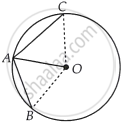Advertisements
Advertisements
Question
Two chords AB and AC of a circle with centre O are on the opposite sides of OA. Then ∠OAB = ∠OAC .
Options
True
False
Solution
This statement is False.
Explanation:
We have,

In ΔOAB and ΔOAC,
OA = OA ...[Common]
OB = OC ...[Radii of a same circle]
Here, we are not able to show that either any angle or third side is equal and ΔOAB is not congruent to ΔOAC.
∴ ∠OAB ≠ ∠OAC
APPEARS IN
RELATED QUESTIONS
Two circles of radii 5 cm and 3 cm intersect at two points and the distance between their centres is 4 cm. Find the length of the common chord.
If a line intersects two concentric circles (circles with the same centre) with centre O at A, B, C, and D, prove that AB = CD (see given figure).

An equilateral triangle of side 9cm is inscribed in a circle. Find the radius of the circle.
In a circle with centre O, AB and CD are two diameters perpendicular to each other. The length of chord AC is
Two equal circles of radius r intersect such that each passes through the centre of the other. The length of the common chord of the circle is
If AB is a chord of a circle, P and Q are the two points on the circle different from A and B, then
In a circle of radius 17 cm, two parallel chords are drawn on opposite side of a diameter. The distance between the chords is 23 cm. If the length of one chord is 16 cm, then the length of the other is
Two congruent circles with centres O and O′ intersect at two points A and B. Then ∠AOB = ∠AO′B.
If two equal chords of a circle intersect, prove that the parts of one chord are separately equal to the parts of the other chord.
AB and AC are two chords of a circle of radius r such that AB = 2AC. If p and q are the distances of AB and AC from the centre, prove that 4q2 = p2 + 3r2.
